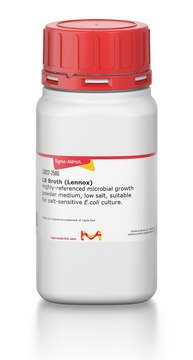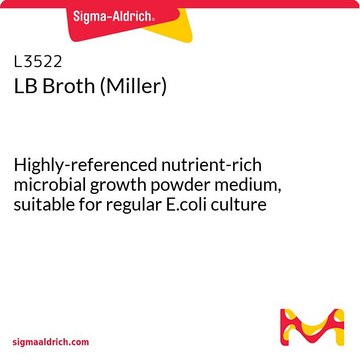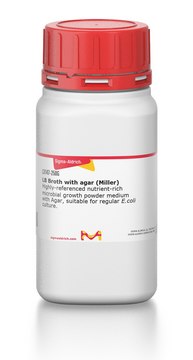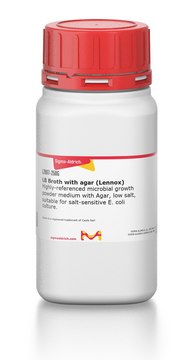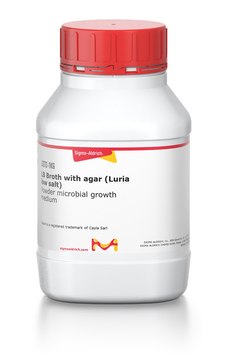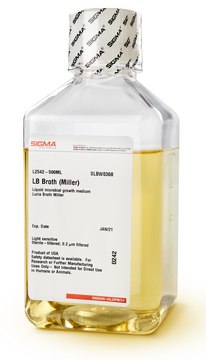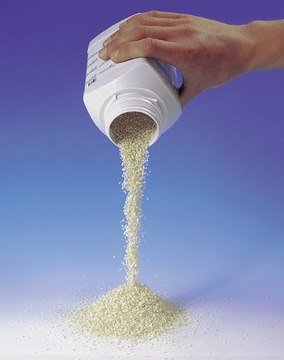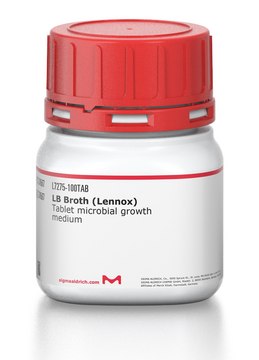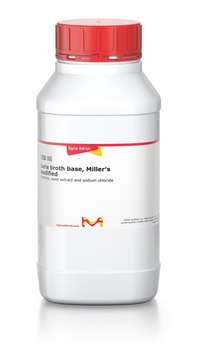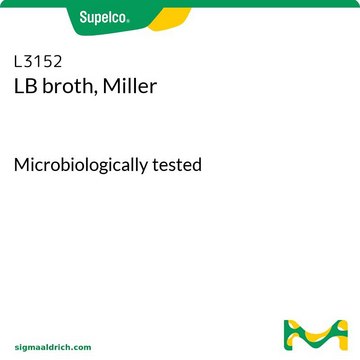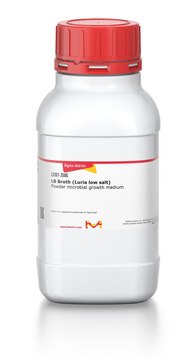推荐产品
等级
Molecular Biology
质量水平
无菌性
non-sterile
表单
powder
组成
NaCl, 0.5 g/L
Tryptone, 10 g/L
Yeast Extract, 5 g/L
技术
microbiological culture: suitable
pH值(酸碱度)
6.8-7.2(1.55% solution)
适用性
suitable for molecular biology
nonselective for Escherichia coli
nonselective for coliforms
应用
food and beverages
microbiology
储存温度
room temp
1 of 4
此商品 | L3272 | L3522 | L3022 |
|---|---|---|---|
| form powder | form powder | form powder | form powder |
| suitability suitable for molecular biology, nonselective for Escherichia coli, nonselective for coliforms | suitability - | suitability - | suitability - |
| sterility non-sterile | sterility non-sterile | sterility non-sterile | sterility non-sterile |
| composition NaCl, 0.5 g/L , Yeast Extract, 5 g/L , Tryptone, 10 g/L | composition Agar, 15 g/L , NaCl, 0.5 g/L , Tryptone, 10 g/L , Yeast Extract, 5 g/L | composition NaCl, 10 g/L , Tryptone, 10 g/L , Yeast Extract, 5 g/L | composition NaCl, 5 g/L , Tryptone, 10 g/L , Yeast Extract, 5 g/L |
| application(s) food and beverages | application(s) food and beverages | application(s) food and beverages | application(s) food and beverages |
一般描述
应用
特点和优势
- Standard formulation
- A budget-friendly alternative to liquid
- Easy scale-up using larger package sizes
制备说明
2. Autoclave for 15 minutes at 121°C.
重悬
相关产品
储存分类代码
11 - Combustible Solids
WGK
WGK 3
闪点(°F)
Not applicable
闪点(°C)
Not applicable
法规信息
历史批次信息供参考:
分析证书(COA)
Which document(s) contains shelf-life or expiration date information for a given product?
If available for a given product, the recommended re-test date or the expiration date can be found on the Certificate of Analysis.
How do I get lot-specific information or a Certificate of Analysis?
The lot specific COA document can be found by entering the lot number above under the "Documents" section.
How do I find price and availability?
There are several ways to find pricing and availability for our products. Once you log onto our website, you will find the price and availability displayed on the product detail page. You can contact any of our Customer Sales and Service offices to receive a quote. USA customers: 1-800-325-3010 or view local office numbers.
What is the Department of Transportation shipping information for this product?
Transportation information can be found in Section 14 of the product's (M)SDS.To access the shipping information for this material, use the link on the product detail page for the product.
What are the differences among the Luria, Lennox and Miller LB formulations?
LB, (originally termed lysogeny broth) was initially composed of tryptone, yeast extract, NaCl and glucose. Soon after, the glucose was omitted (Miller's version), and later the NaCl content lowered by half (Lennox's version). For some applications, even lower salt is required (Luria's low salt version).
What is the difference between the LB - Luria low salt products?
LB - Luria low salt is available in both powder (L3397) and powder with agar formats (L3272).
Which bacterial culture medium is the best choice for my application?
Each of the broths will likely grow E. coli very well, but there are still general guidelines for choosing a broth when you are working without a protocol. Generally:LB - Miller and LB - Lennox are used for E. coli growth and maintanence, DNA plasmid production and protein production. The Lennox formulation has a lower salt content required for some salt-sensitive selection antibiotics.LB - Luria low salt is used for special applications where the E. coli growth or other constraints require the lowest possible salt content.Terrific Broth is used for higher yield protein production and high yield DNA plasmid production, because of the faster growth of the E. coli in this medium.SOB is used for protein production, DNA plasmid production and the generation of high-efficiency competent cells.SOC is used for initial growth of competent cells and the transformation procedure.
Will adding magnesium to the culture medium increase cell density?
In microbial broth formulations that do not already contain magnesium, the addition of 10-20 mM MgCl2 or MgSO4 may increase cell densities. You may need to also increase the shaking speed of the incubator.
My question is not addressed here, how can I contact Technical Service for assistance?
Ask a Scientist here.
实验方案
General protocols for growth of competent cells in microbial medium.
在从小型培养到发酵级的不同规模下培养大肠杆菌。包括了用于启动起始培养物、悬浮细胞、单一培养物和平板噬菌体M13的实验方案。
我们的科学家团队拥有各种研究领域经验,包括生命科学、材料科学、化学合成、色谱、分析及许多其他领域.
联系客户支持